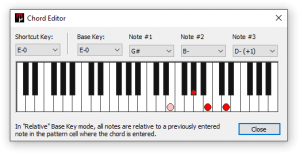Manual: Chord Editor
Jump to navigation
Jump to search
The Chord Editor is used to define the preset chords that can be entered into the Pattern Editor by holding the chord modifier key.
- Shortcut Key: The note that, when input, will trigger the chord input. The displayed octave is relative to the base octave; i.e. C-0 is the lowest octave on your keyboard, and pressing this note together with the chord modifier key (Shift by default) will enter the notes from the following fields.
- Base Note: The base note of the chord; however, it doesn’t have to be the lowest note of the chord. There are two possible modes for the base note:
- Relative: The base note is taken as the note in the pattern position where the chord is entered. All notes in the chord are relative to that note. If the pattern cell is empty, the previous base note is used instead.
- Note: Any other base note value uses the chosen note as the base note and adds the base octave.
- Notes 1 – 3: The alternate notes that will be input in the other channels being recorded into.
- Chord Diagram: The piano keyboard representation of the chord, with a light red dot indicating the base note and the bright red dots indicating the remaining notes belonging to the chord. You can drag the dots around to change existing notes, or click on an empty key to add another note to the chord (up to 4 at a time). To remove a note from the chord, click on the red dot so it is deleted (not possible for the base note).
